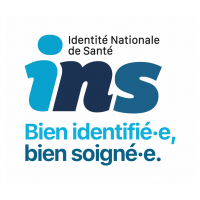L’Identité Nationale de Santé (ex-Identifiant National de Santé depuis le 8 avril 2021, cf. communiqué de presse) est un identifiant unique et propre à chaque usager, il s’agit d’une identité numérique unique, univoque et pérenne. L’objectif est de renforcer la fiabilité de l’identification du patient et de contribuer ainsi à la qualité de la prise en charge et à la sécurité des soins. L’INS est utilisé pour référencer les données de santé et les données administratives, il permet de faciliter l’échange et le partage des données.
L’utilisation de l’identité INS est obligatoire pour les professionnels de la santé et du médico-social impliqués dans la prise en charge du patient. Depuis le 1er janvier 2021, tous les logiciels de santé doivent intégrer l’Identité Nationale de Santé.
Matricule INS
NIR ou NIA
NIR : Numéro d’inscription au répertoire national des personnes physiques.
NIA : Numéro d’identifiant en attente
Traits INS
Traits d’identité de référence
Les traits d’identité de référence provenant de la base nationale d’état civil : nom de naissance, le(s) prénom(s) de naissance, la date de naissance, le sexe et le lieu de naissance.
OID
(Object identifier)
Autorité d’affectation de l’identifiant (origine et type d’informations).
Il est à noter que l’OID est transparent pour l’utilisateur.
Point d’attention :
Dans certains cas le matricule INS peut être différent du numéro de sécurité sociale (servant au remboursement des frais de santé), notamment si l’usager n’est pas l’assuré (par exemple dans le cas de la prise en charge d’un enfant assuré par l’un de ses parents).
L’INS doit être qualifiée en répondant aux deux conditions suivantes :
- Elle doit provenir des bases nationales de référence ou être vérifiée par rapport à ces bases eu utilisant le téléservice INSi mis en œuvre par l’Assurance Maladie,
- Elle est associée à l’identité de l’usager uniquement si cette identité a été vérifiée selon les procédures d’identitovigilance en vigueur.
Le téléservice INSi
Il est nécessaire de se doter d’une carte CPx nominative pour accéder au téléservice INSi (CPS Carte Professionnelle de Santé, CPE Carte du Personnel d’Etablissement, CPF Carte du Personnel en Formation).
Le téléservice INSi propose deux opérations : la récupération de l’identité INS et la vérification de l’INS.
Opération de récupération, deux modalités sont possibles :
- Lecture automatique de la carte vitale de l’usager.
- Saisie des traits (a minima : nom de naissance, un des prénoms de naissance, date de naissance et le sexe).
Les données qui vous sont transmises proviennent des bases nationales de l’état civil : nom de naissance, prénom(s) de naissance, date de naissance, sexe, lieu de naissance (code INSEE) et matricule INS.
Opération de vérification, deux cas possibles :
- Un partenaire extérieur à votre structure vous transmet une identité INS qui n’est pas encore qualifiée,
- Vous voulez vérifier la conformité des identités INS qui sont présentes dans votre base par rapport aux bases de référence.
Une des exigences du référentiel INS est de vérifier tous les 3 à 5 ans la conformité des identités INS de votre base par rapport aux bases de référence.
La vérification de l’identité de l’usager (identitovigilance)
Un Référentiel National de l’IdentitoVigilance (RNIV) fixe les exigences et les recommandations en termes d’identification des usagers.
Ce référentiel comprend un socle commun à tous les structures et plusieurs volets spécifiques (établissements de santé, structures hospitalières, structures libérales, …).
Le RNIV précise que pour créer une identité, il faut saisir le nom de naissance, le 1er prénom de naissance (a minima), la date de naissance, le sexe et lieu de naissance (code INSEE).
Une fois que vous avez fait appel au téléservice INSi, vous pouvez compléter l’identité avec la liste des prénoms de naissance et le matricule INS (s’il existe avec son OID).
Les règles de saisie sont :
- Nom et prénoms en majuscule,
- Pas d’accent,
- Pas de caractère diacritique,
- Tiret et apostrophe conservés.
L’attribution du statut de l’identité (niveau de confiance) est obligatoire :
- Identité provisoire (si le contrôle de cohérence entre les traits d’identité saisis et une pièce d’identité à haut niveau de confiance n’a pas été réalisé),
- Identité validée (si le contrôle de cohérence a été réalisé),
- Identité récupérée (si l’identité a été créée par appel du téléservice INSi),
- Identité qualifiée (si l’identité récupérée par le téléservice INSi et la cohérence entre les traits d’identité a été vérifiée à l’aide d’une pièce d’identité ou un dispositif d’identification de haut niveau de confiance).
Les pièces d’identité à haut niveau de confiance sont la carte d’identité, le passeport, pour les enfants un extrait d’acte de naissance ou le livret de famille accompagné d’une pièce d’identité de l’un des 2 parents.
Il est interdit de procéder à la validation automatique des identités sans présentation et contrôle d’une pièce d’identité à haut niveau de confiance.
Textes de référence :
-Décret d’application n°2019-1036 du 8 octobre 2019 modifiant le décret n° 2017-412 du 27 mars 2017
-Référentiel Identifiant National de Santé
-Référentiel national de l’identitovigilance RNIV
-Guide d’implémentation de l’identité INS dans les logiciels
>> Plus d’informations sur le site de l’ANS : L’Identité Nationale de Santé (INS), identité clé du système de santé






